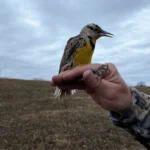
North America’s grassland birds are in jeopardy. According to a report co-authored by American Bird Conservancy (ABC), more than 720 million grassland birds in the U.S. and Canada have been lost since 1970.
To inform grassland habitat conservation, ABC is teaming up with partners to better understand the movements of grassland birds and the threats they face. As part of this effort, ABC and partners will track the movements of one specific grassland species, the Eastern Meadowlark, this fall and winter to learn more about their nonbreeding season behavior and locations.

“Eastern Meadowlarks are one of our most common and most visible grassland birds, and for many people their song is one of the first signs of spring,” said Jim Giocomo, ABC’s Central Regional Director. “Their decline is telling us about the loss of grasslands on a massive scale.”
With its bright yellow belly and fluid, flute-like song, the Eastern Meadowlark is one of the country’s most recognizable grassland songbirds. Millions of these birds sing across the grasslands of the eastern U.S. each spring and summer — but there were once millions more. Largely due to intensive agriculture, this common bird has become much less common in the past half century, with numbers plummeting by 75 percent.
To help stop and reverse the species’ decline, conservationists need to understand where Eastern Meadowlarks spend each season, and which conditions are ideal for raising the next generation. Unfortunately, there’s a surprising amount that scientists don’t know about these charismatic birds. Even basic information about meadowlark migratory patterns remain a mystery. Biologists are working to fix that before it’s too late.

A consortium of conservationists and researchers have teamed up to gather crucial information about the species in the southern part of its range, where its movements are most poorly understood. Earlier this year, ABC, the Central Hardwoods Joint Venture, and several other organizations placed tiny GPS transmitters on six meadowlarks in Indiana, Kentucky, Louisiana, and Mississippi. The trackers will allow scientists to follow tagged birds through the fall season and observe where they spend the winter months.
The information collected will help future Eastern Meadowlark habitat conservation efforts. For instance, the insight gained will help ABC work with private landowners to manage their property with meadowlarks in mind — the majority of the species’ range is located on private lands.
“Using the latest technology and building a large partnership across North America, we are hoping to learn more about our common grassland birds,” Giocomo said. “This will help us reverse the steep population declines through collaborative habitat management programs across the seasons.”
###
American Bird Conservancy (ABC) takes bold action to conserve wild birds and their habitats throughout the Americas. Inspired by the wonder of birds, we achieve lasting results for the bird species most in need while also benefiting human communities, biodiversity, and the planet’s fragile climate. Our every action is underpinned by science, strengthened by partnerships, and rooted in the belief that diverse perspectives yield stronger results. Founded as a nonprofit organization in 1994, ABC remains committed to safeguarding birds for generations to come. Join us! Together, we can do more to ensure birds thrive.
Media Contact
Jordan Rutter
Director of Communications
media@abcbirds.org